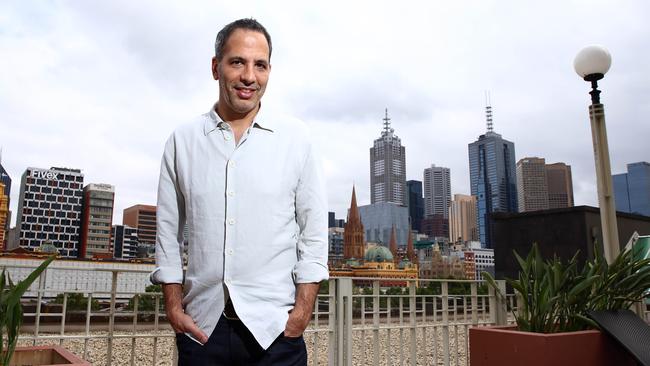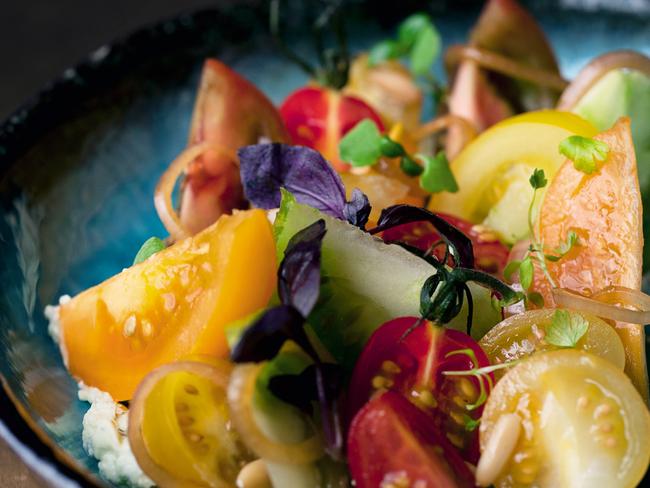Rise of the Yotam Ottolenghi empire
He’s become a household name by making vegetables sexy, but Yotam Ottolenghi almost didn’t become a chef.

Let’s get something straight: Yotam Ottolenghi isn’t just a vegetarian cook. True, few have done as much for the eggplant since the invention of baba ganoush, and his book Plenty is devoted to “vibrant vegetable recipes”, but his repertoire delivers more than the odd nod to the carnivore.
Dishes such as beef shin pastilla, fennel and radish, or dukkah-crusted mackerel with burnt aubergine yoghurt, feature prominently on the menus of his eponymous restaurants and delis.
Nevertheless, the Ottolenghi hallmark remains those vivid vegetable creations and, while he baulks at suggestions he reinvented the salad, he certainly has given it a makeover.
“If you take a good cut of meat — the same applies to fish or seafood — you don’t need to do that much to it,” he says. “Vegetables take a bit more work but they pay back with lots of TLC as well because they are good for you and they are much more versatile.”
Ottolenghi’s culinary masterstroke was to re-create the tableau of the markets in his native Israel for a receptive London audience. I ate at the original cafe in north London a decade ago, and still remember the splash of colour his food delivered on a hazy winter’s day.
“There’s an element of originality in what we’re doing, but if you come to Ottolenghi, then go to the Carmel Market in Tel Aviv, then it’s the same family of things — displaying food really beautifully,” he says. “I think we brought them into a Western urban context because it’s not just like creating a fruit and veg market in the style of Istanbul or Jerusalem; it’s taking the sensibilities of that food culture and modernising it.”
If you’ve never attempted an Ottolenghi recipe, you’ll need a keen palate, an open mind and a long shopping list — although he is far from precious about his creations.
“My recipes have a lot of ingredients — I’m quite famous for that — but if you substitute one it’s not the end of the world,” he says.
“I want people to experience, rather than to feel that they are following some godly word from above.”
This tall (190cm), companionable man is in some ways the antithesis of what we’ve come to expect from high-profile chefs, which he puts down to knowing something of life beyond the pass.
“I’ve got an unusual background (for a cook) — I hadn’t been in a kitchen since the age of 15, going through the ranks and getting almost desensitised to the outside world,” he says.
“I’ve arrived in my late 20s and I’ve done other things so I have a lot of respect for home cooks, how they do it, and their difficulties and achievements, so that, I think, helps as well.”
In fact, Ottolenghi’s talents could so easily have found another outlet. He was a gifted scholar and destined to follow in the footsteps of his lecturer parents, while journalism also beckoned. A stint at Tel Aviv newspaper Haaretz piqued his interest, as he savoured the adrenalin of working on a busy newsdesk, “everyone smoking, all these green screens”.
But when he opted in his late 20s to cook, it was an apparent dalliance that troubled his chemistry professor father.
“What my dad did — he did it smartly — was to write me a letter,” Ottolenghi says. “He said, ‘I don’t think it’s the right choice because I think you’re throwing away a potential career that you have, but if you’ve got to do it, you’ve got to do it.’ ”
Ottolenghi senior must be relieved his preference was largely ignored: Yotam is a household name in Britain, and his profile in Australia is about to rise with his stint as an international “name” for this year’s MasterChef TV series. But don’t expect Marco Pierre White-style exhortations as the clock ticks down.
“I find it very difficult when I need to be hard on someone,” he says. “That’s true about my personal life and professional life; I’ve got other people doing the bad cop jobs for me normally, but when I need to say things that need to be said, I say them.”
He takes his role on MasterChef seriously: “People forget the contestants are not only there to entertain, they are there to be trained and learn, and I see this as an important mission. These people are giving up months of their lives.” Such empathy may be part of the reason for his popularity (I remind him of the genuine warmth from fans during a previous trip to Australia), though when asked what may inspire this, he is somewhat bashful.
“Maybe I’m not the person to ask,” he says. “I guess I’m not your typical chef so I don’t take on this persona of: ‘Here I am to show you how it’s done, it’s either my way or the highway’.”
If he’s not the person to ask, Ramael Scully certainly is. The Malaysian-born, Sydney-reared chef is an integral part of the Ottolenghi team, and co-wrote his new cookbook NOPI, named after the grandest of the five outlets (the name is taken from its location, north of Piccadilly).
Does Mr Nice Guy ever reach boiling point?
“Not from what I’ve seen,” says Scully. “I don’t think he can lose his cool, to be honest. There is always going to be a little argument about the food but we always resolve it by making the dish better. He’s very straightforward and helpful and knowledgeable.
“It’s like Momofuku in New York — David Chang built his empire through a great bunch of people who love and are passionate about food. It’s the same thing with Ottolenghi in London.”
One of those is Ottolenghi’s head chef and business partner Sami Tamimi, who has been on-board from the start. Both are from Jerusalem, via Tel Aviv, but Ottolenghi, who is Jewish, and Tamimi, an Arab, met on the neutral turf of London. Ottolenghi steers clear of clumsy symbolism, but acknowledges how food can unite.
“Twenty-first century food has definitely been at the forefront of bringing down boundaries, bringing down walls. People started understanding other cultures through their food,” Ottolenghi says.
“Think how many people have been to Japan from Europe, but how many of us have been exposed to the sensibility of this culture through food? So many that we feel we know it. We do, to a degree, and I think the same applies to the food of the Middle East. Maybe people haven’t travelled there but they get a certain understanding through experiencing the food.”
Ottolenghi’s next venture is a book about desserts, Sweet, but for now, he’s still the man who makes beautiful salads — and who made salads beautiful.
TOMATOES WITH WASABI MASCARPONE AND PINE NUTS
This is all about the tomatoes, so get as many different varieties as you can: red, green and yellow; baby plum, cherry and vine. They also look great if they are not cut in uniform fashion: smaller tomatoes should be halved, while larger ones should be cut into wedges or sliced.
You can prepare all the elements for this in advance — the wasabi and herb-filled mascarpone, the pickled shallots, the chopped tomatoes, the toasted nuts. Just keep them separate and put the dish together just before serving.
This developed from a dish which Sarit Packer developed with Scully for the breakfast menu when NOPI first opened, when the wasabi mascarpone was served with smoked salmon and scrambled eggs.
Yotam brought in the tomatoes and the dish was reborn and shifted on to the summer lunch menu. It works well as part of a spread of salads or alongside some simply cooked fish or meat.
Serves 6
250g mascarpone
1 tbsp wasabi paste
10g chives, Finely chopped
10g tarragon, Finely chopped
1 spring onion, Finely sliced (20g)
2 banana shallots (echalion), thinly sliced widthways (100g)
2 tbsp Pedro Ximenez sherry vinegar (or another good-quality sweet sherry vinegar)
1 tbsp olive oil
1kg mixed tomatoes, cut into a mixture of slices and wedges, 1cm thick
20g pine nuts, toasted
5g mixed basil leaves (plain, purple and micro-basil) or just plain basil, to garnish
Coarse sea salt and black pepper

1. Place the mascarpone, wasabi, chives, tarragon and spring onion in a bowl with ½ teaspoon of salt and a good grind of black pepper. Mix well and keep in the fridge until ready to use.
2. Place the shallots in a separate bowl with the sweet vinegar, oil and ½ teaspoon of salt. Mix well and keep in the fridge until ready to use.
3. To serve, divide the mascarpone between the plates and spread it out to form a thin layer. Place the tomatoes on top, followed by the pickled shallots. Sprinkle with the pine nuts, then scatter over the basil leaves, tearing the larger ones as you go. Season with 1/3 teaspoon of salt and a good grind of black pepper, and serve
Extracted from NOPI: The Cookbook by Yotam Ottolenghi and Ramael Scully (Ebury Press, $59.99). Photography by Jonathan Lovekin
